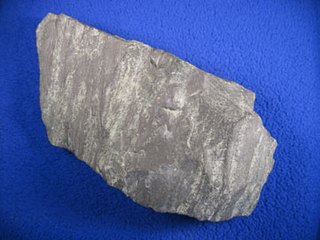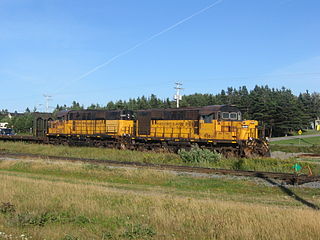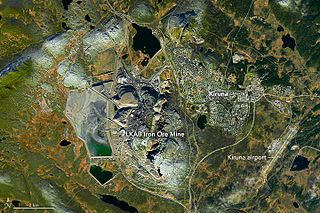
Ore is natural rock or sediment that contains one or more valuable minerals, typically containing metals, that can be mined, treated and sold at a profit. Ore is extracted from the earth through mining and treated or refined, often via smelting, to extract the valuable metals or minerals. The grade of ore refers to the concentration of the desired material it contains. The value of the metals or minerals a rock contains must be weighed against the cost of extraction to determine whether it is of sufficiently high grade to be worth mining, and is therefore considered an ore.

Iron ores are rocks and minerals from which metallic iron can be economically extracted. The ores are usually rich in iron oxides and vary in color from dark grey, bright yellow, or deep purple to rusty red. The iron is usually found in the form of magnetite (Fe
3O
4, 72.4% Fe), hematite (Fe
2O
3, 69.9% Fe), goethite (FeO(OH), 62.9% Fe), limonite (FeO(OH)·n(H2O), 55% Fe) or siderite (FeCO3, 48.2% Fe).

Taconite is a variety of iron formation, an iron-bearing sedimentary rock, in which the iron minerals are interlayered with quartz, chert, or carbonate. The name "taconyte" was coined by Horace Vaughn Winchell (1865–1923) – son of Newton Horace Winchell, the Minnesota State Geologist – during their pioneering investigations of the Precambrian Biwabik Iron Formation of northeastern Minnesota. He believed the sedimentary rock sequence hosting the iron-formation was correlative with the Taconic orogeny of New England, and referred to the unfamiliar and as-yet-unnamed iron-bearing rock as the 'taconic rock' or taconyte.

Wawa is a township in the Canadian province of Ontario in the Algoma District. Formerly known as the Township of Michipicoten, named after a nearby river of that name, the township was officially renamed in 2007 for its largest and best-known community of Wawa, located on the western shores of Wawa Lake.

The term Iron Range refers collectively or individually to a number of elongated iron-ore mining districts around Lake Superior in the United States and Canada. Despite the word "range", the iron ranges are not mountain chains, but outcrops of Precambrian sedimentary formations containing high percentages of iron. These cherty iron ore deposits are Precambrian in age for the Vermilion Range and middle Precambrian in age for the Mesabi and Cuyuna ranges, all in Minnesota. The Gogebic Range in Wisconsin and the Marquette Iron Range and Menominee Range in Michigan have similar characteristics and are of similar age. Natural ores and concentrates were produced from 1848 until the mid 1950s, when taconites and jaspers were concentrated and pelletized, and started to become the major source of iron production.
The Cartier Railway is a privately owned railway that operates 260 miles (418 km) of track in the Canadian province of Québec.

The Wabush Lake Railway is a short line railway operating in the province of Newfoundland and Labrador, Canada.

Schefferville is a town in the Canadian province of Quebec. Schefferville is in the heart of the Naskapi and Innu territory in northern Quebec, less than 2 km from the border with Labrador on the north shore of Knob Lake. It is located within the Caniapiscau Regional County Municipality and has an area of 25.11 square kilometres (9.70 sq mi). Schefferville completely surrounds the autonomous Innu community of Matimekosh, and it abuts the small community of Lac-John Reserve. Both of the latter communities are First Nations Innu reserves. Schefferville is also close to the Naskapi reserved land of Kawawachikamach.

The North Shore of Lake Superior runs from Duluth, Minnesota, United States, at the southwestern end of the lake, to Thunder Bay and Nipigon, Ontario, Canada, in the north to Sault Ste. Marie, Ontario, in the east. The shore is characterized by alternating rocky cliffs and cobblestone beaches, with forested hills and ridges through which scenic rivers and waterfalls descend as they flow to Lake Superior.

Sherman Mine is a closed open pit mine in Temagami, Ontario, Canada. It was a major producer of iron ore, starting production in 1968 and closing in 1990. Sherman was the largest open pit mine in Temagami, consisting of seven open pits known as the East Pit, South Pit, North Pit, West Pit and the Turtle Pits. The mine was discovered in the early part of the twentieth century, however interest was limited as a result of silver and gold discoveries in northeastern Ontario. While the Ontario government offered bounties to producers of iron ore, there was little interest in putting any iron mine into production as a result of cheaper Mesabi Range ores from the US and the Great Depression. It was only in the 1950s that Canadian steel producers started to investigate domestic supplies of iron ore. This would lead to the re-opening of the Moose Mountain Mine and development of the Adams, Sherman and Bruce Lake mines in Northern Ontario. The Sherman Mine operated in tandem with the Adams Mine in Kirkland Lake, and when the Adams Mine approached exhaustion of its economic ore reserves, the decision was made to also close the Sherman Mine. The surface infrastructure was removed and the site was abandoned. The waste piles are currently used by the municipality as a source of crushed stone for road works.
Cleveland-Cliffs Inc., formerly Cliffs Natural Resources, is a Cleveland, Ohio-based company that specializes in the mining, beneficiation, and pelletizing of iron ore, as well as steelmaking, including stamping and tooling. It is the largest flat-rolled steel producer in North America.

The Gogebic Range is an elongated area of iron ore deposits located within a range of hills in northern Michigan and Wisconsin just south of Lake Superior. It extends from Lake Namakagon in Wisconsin eastward to Lake Gogebic in Michigan, or almost 80 miles. Though long, it is only about a half mile wide and forms a crescent concave to the southeast. The Gogebic Range includes the communities of Ironwood in Michigan, plus Mellen and Hurley in Wisconsin.

The Kiruna mine is the largest and most modern underground iron ore mine in the world. The mine is located in Kiruna in Norrbotten County, Lapland, Sweden. The mine is owned by Luossavaara-Kiirunavaara AB (LKAB), a large Swedish mining company. In 2018 the mine produced 26.9 million tonnes of iron ore. The Kiruna mine has an ore body which is 4 km (2.5 mi) long, 80 metres (260 ft) to 120 metres (390 ft) thick and reaching a depth of up to 2 km (1.2 mi). Since mining began at the site in 1898, the mine has produced over 950 million tonnes of ore.

The Jackson Mine is an open pit iron mine in Negaunee, Michigan, extracting resources from the Marquette Iron Range. The first iron mine in the Lake Superior region, Jackson Mine was designated as a Michigan State Historic Site in 1956 and listed on the National Register of Historic Places in 1971. The Lake Superior Mining Institute said, the mine "is attractive in the iron ore region of Michigan and the entire Lake Superior region, because of the fact it was here that the first discovery of iron ore was made, here the first mining was done, and from its ore the first iron was manufactured." Multiple other mines soon followed the Jackson's lead, establishing the foundation of the economy of the entire region. The mine is located northwest of intersection of Business M-28 and Cornish Town Road.
The Quebec North Shore and Labrador Railway is a private Canadian regional railway that stretches 414 kilometres (257 mi) through the wilderness of northeastern Quebec and western Labrador. It connects Labrador City, Labrador, with the port of Sept-Îles, Quebec, on the north shore of the St. Lawrence River. QNS&L is owned by Iron Ore Company of Canada (IOC), and is a common carrier.
Steep Rock Lake is a body of water near the township of Atikokan, northern Ontario, Canada. It was originally fed by the Seine River.
The Cacova Ierii mine is a large open pit mine in the north-western of Romania in Cluj County. Cacova Ierii represents one of the largest iron ore reserves in Romania having estimated reserves of 16.6 million tonnes of ore grading 42% iron metal. The mine has the capability to produce around 415,000 tonnes of iron ore/year.
The Howells Lake-Howells River North mine is a large iron mine located in east Canada in Newfoundland and Labrador. Howells Lake-Howells River North represents one of the largest iron ore reserves in Canada and in the world having estimated reserves of 11.74 billion tonnes of ore grading 22% iron metal.

Western Labrador Rail Services, Inc. is a rail operation of Genesee & Wyoming Canada, Inc. created in 2010 by the combination of three short line railways: Arnaud Railway, Bloom Lake Railway, and Wabush Lake Railway. The operation provides rail transportation services to mining companies operating in the provinces of Newfoundland and Labrador and Québec, Canada.

Fire Lake is a lake in the Côte-Nord region of Quebec, Canada. It was the location of a major open pit mining operation in the 1970s and 1980s. Operations were then suspended for twenty years, but ArcelorMittal resumed extraction in 2006.











